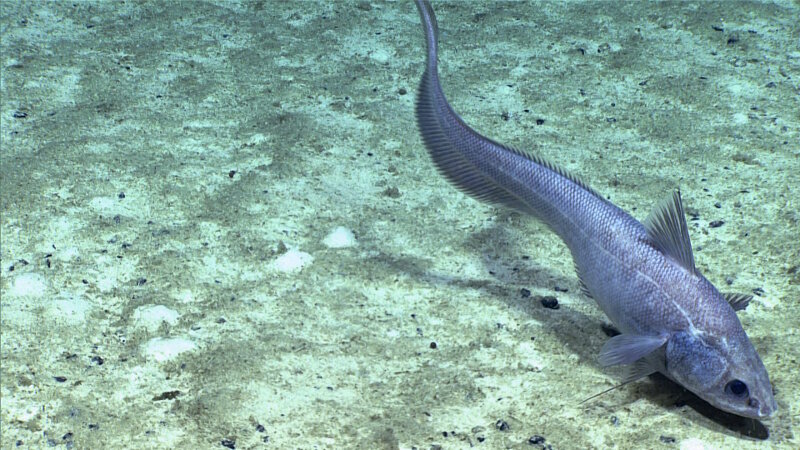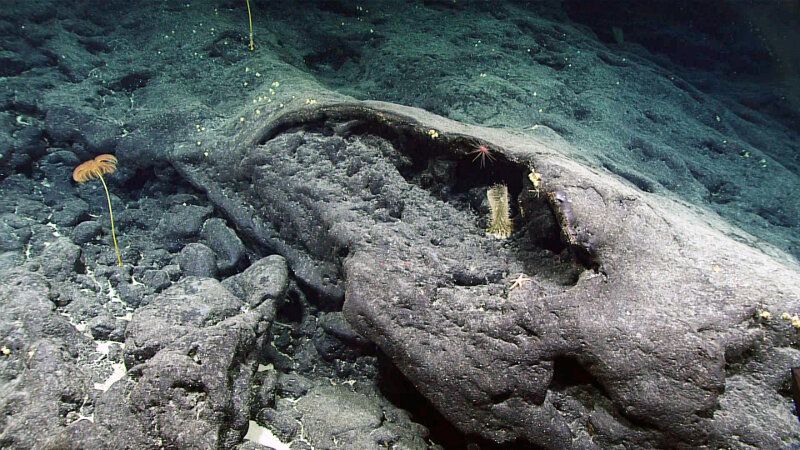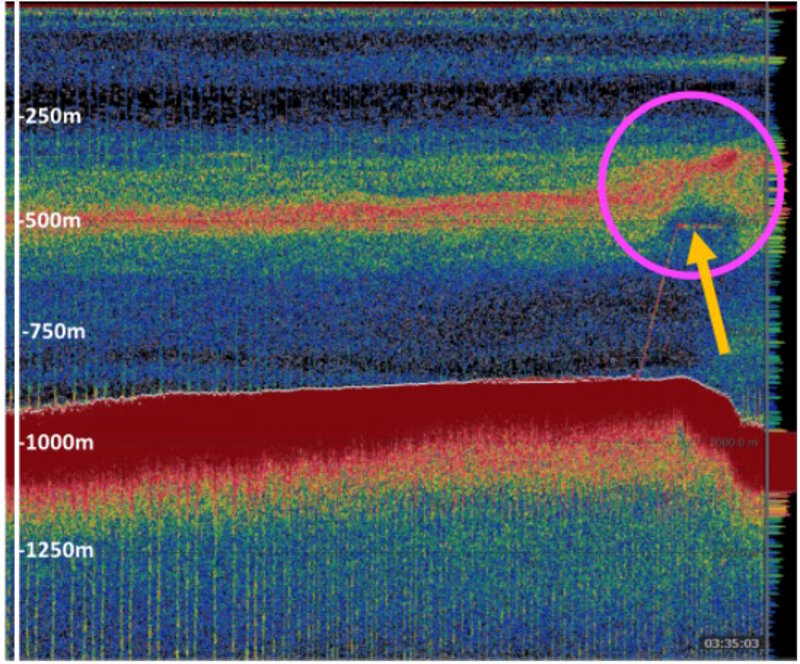
By Astrid Leitner - University of Hawaii at Manoa
May 11, 2017

A rattail (Coryphaenoides sp.) swims over a heavily sedimented, soft bottom during Dive 08 of the Mountains in the Deep Expedition. Image courtesy of the NOAA Office of Ocean Exploration and Research, Mountains in the Deep: Exploring the Central Pacific Basin. Download larger version (jpg, 2.0 MB).
Despite getting many wonderful and interesting fish observations throughout these dives, the frequency of fish observations is relatively low, especially compared to how often we observed and imaged corals, brittle stars, and sea stars. This could truly represent low fish abundances at these sites, possibly because we weren't working in their preferred habitats. Another explanation is that we see few fish because they are mobile and avoid the bright, noisy remotely operated vehicle (ROV).
In shallow water, many fish live in complex, rocky habitats like kelp forests, coral reefs, and rocky reefs. Even down to the depths sampled in the shallowest that NOAA Ship Okeanos Explorer conducts dives – around 500 meters (1,640 feet) and shallower – we observe fish hiding in rocky overhangs and nooks. However, in the deeper dives of the Campaign to Address Pacific monument Science, Technology, and Ocean NEeds (CAPSTONE) expeditions, we generally observe more fishes in areas with at least some soft sediment – sand or mud. Dives with a lack of sediments are also typically characterized by a pronounced lack of fish observations.

This image from Dive 04 of the expedition, shows a hard substrate-dominated seafloor with a variety of sessile filter feeders (stalked crinoids, glass sponge, barnacles), but no fishes. Image courtesy of the NOAA Office of Ocean Exploration and Research, Mountains in the Deep: Exploring the Central Pacific Basin. Download larger version (jpg, 1.9 MB).
Several hypotheses have been suggested to try to explain this apparent shift in habitat association with depth. One idea is that in the deep sea, sedimented habitats support more potential prey items. Sediments can support rich and diverse animals living both in the sediments (infauna) and on the sediment surface (epifauna). This would, for example, include small crustaceans and polychaete worms, which we commonly find in deep-sea fish stomachs. On the other hand, common animals in rocky areas, such as corals and sponges, are rarely eaten by deep-sea fishes.
Another hypothesis has to do with energy and metabolism. Generally, areas in the deep sea which are not sediment covered experience higher bottom currents. Since filter feeders like corals and sponges depend on the currents to deliver their food, they prefer habitats with higher currents where they can get food at a faster rate. This is one of the reasons that we tend to find coral communities in hard substrate and exposed rock areas like seamount ridges. However, higher currents may make these habitats too energetically costly for fishes – they would have to battle the currents in order to swim and forage. Therefore, the relatively low frequency of fish sightings could be reflective of a real lower abundance in the hard substrate deep-sea habitats.
On the other hand, the lack of fish observations could be due to the way we are making our observations. ROVs are often large and noisy with powerful lights. They can also cause a large amount of water disturbance from the thrusters. Highly mobile animals, like fish, likely sense the ROV from a long distance off. They may swim away before we are able to image them.
A clear example of ROV avoidance is seen at the beginning and end of each dive, as we transit through the midwater. The deep scattering layer, which can be made of mostly lantern fishes (Myctophidae) or bristlemouth fishes (Gonostomatidae), will disperse just ahead of the ROV.

This is an echogram showing acoustic backscatter data from the EK60 aboard NOAA Ship Okeanos Explorer. The dark red region represents the seafloor, and the thin red trace is from the ROV. The green, yellow, and red higher intensity backscatter represents animals of the deep scattering layer in midwater. ROV avoidance is clearly visible (within the pink circle) with the dark blue area surrounding the ROV (highlighted by the yellow arrow) at 500 meters (1,640 feet) depth and the upward displacement of the scattering layer animals. Image courtesy of the NOAA Office of Ocean Exploration and Research, Mountains in the Deep: Exploring the Central Pacific Basin. Download image (169 KB).
Additionally, we tend to see fishes when we first reach bottom. This may be because we can sneak up on fishes by dropping in from above without giving them time to react and swim away. Alternative deep-sea sampling techniques, such as baited cameras, deal with avoidance by attracting fishes and scavengers in front of a stationary camera. They can efficiently collect many fish observations over the course of a day-long deployment, often species that the ROV never sees! However, fish that aren't attracted to bait can be observed by the ROV, but not the baited cameras.
For mobile species, like fishes, it is clear that a combination of techniques can give us the best picture of what lives in the neighborhood.